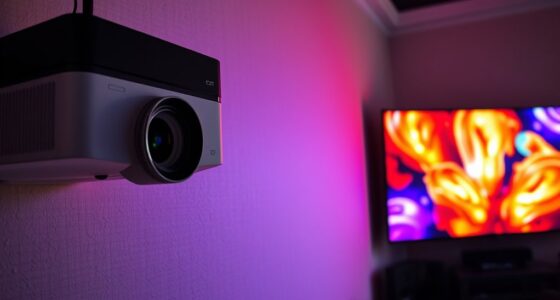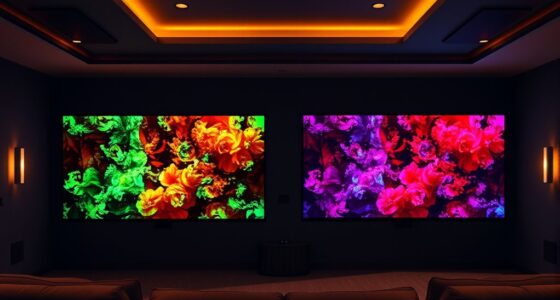Laser light sources play a key role in color reproduction by delivering highly precise, narrow wavelengths that produce vibrant, accurate colors. They outperform traditional lighting by offering better spectral purity, enabling more vivid images and improved color consistency across displays, printing, and imaging systems. With their efficient energy use and fine wavelength control, lasers support advances in visual quality and color accuracy. To understand how this technology is transforming color rendering, explore the detailed benefits and applications.
Key Takeaways
- Laser light sources emit highly specific, narrow spectral wavelengths that enable precise and vivid color reproduction.
- Their spectral coherence and controllable wavelengths enhance color accuracy and consistency across displays and prints.
- Laser-based systems produce monochromatic, high-purity beams that minimize color mismatches and improve spectral fidelity.
- They offer energy-efficient operation and broader color ranges compared to traditional filtering and phosphor methods.
- The use of lasers supports advanced applications requiring exact spectral reproduction and high visual fidelity.
How Laser Light Sources Function in Color Rendering

Laser light sources are vital for achieving accurate color rendering because they emit highly specific wavelengths that match the spectral requirements of various colors. This precision is possible thanks to spectral coherence, which ensures that the emitted light maintains a narrow spectral bandwidth. Wavelength control allows you to fine-tune the laser’s output, selecting exact wavelengths needed for particular colors. Unlike broad-spectrum light sources, lasers produce a concentrated, monochromatic beam that can be precisely adjusted for spectral accuracy. This control over wavelength and spectral coherence means you can reproduce colors more vividly and accurately, reducing color mismatches. Additionally, the ability to verify regulatory compliance ensures that laser-based lighting meets safety and performance standards. By focusing on these properties, laser sources deliver consistent, high-quality color rendering that’s indispensable for applications where color precision matters most.
Advantages of Lasers Over Traditional Lighting Technologies

Compared to traditional lighting technologies, laser light sources offer unparalleled precision and efficiency in color reproduction. Their spectral purity ensures that specific wavelengths are emitted with minimal overlap, resulting in more vibrant and accurate colors. This high spectral purity enhances the clarity and consistency of the reproduced hues, making images more lifelike. Additionally, lasers are highly energy-efficient, converting electrical power directly into light with less waste. This efficiency reduces operational costs and energy consumption, making them more sustainable. Unlike conventional lamps that generate broad-spectrum light requiring filtering, lasers produce narrow, targeted beams that deliver consistent color quality. These advantages make laser light sources a superior choice for applications demanding precise, vivid, and energy-conscious color reproduction. Furthermore, advancements in on-device AI capabilities are enabling smarter control systems that optimize laser performance for even more precise and dynamic color rendering.
Applications of Laser-Based Color Reproduction Systems

Laser-based color reproduction systems find widespread use in high-end digital projectors, where their ability to produce vivid, accurate images enhances cinematic and presentation experiences. Their spectral purity guarantees precise color rendering, while beam coherence maintains sharp, stable images. These systems are also critical in medical imaging, providing detailed, true-to-life visuals. Additionally, they support advanced printing techniques, offering consistent color consistency. The unique properties of laser sources allow for compact, energy-efficient designs suited for various display technologies. Their versatility extends to entertainment, museum displays, and broadcast production, elevating visual quality. Moreover, advancements in laser technology have improved spectral stability, ensuring consistent performance over time. Below is a visual idea representation:
| Application Area | Key Benefit |
|---|---|
| Digital Projectors | Vivid, accurate images with spectral purity |
| Medical Imaging | Precise, stable visuals with beam coherence |
| Printing Techniques | Consistent, true-to-color output |
| Entertainment & Displays | Compact, energy-efficient design |
| Broadcast & Museums | Enhanced visual fidelity |
Enhancements in Color Accuracy and Brightness With Laser Technology

Advancements in laser technology have considerably boosted color accuracy and brightness in display systems. By achieving high spectral purity, lasers produce pure, vivid colors that closely match original hues, enhancing visual fidelity. This spectral precision ensures that each color remains true over time, contributing to improved color stability. As a result, images appear more vibrant and consistent, even during prolonged viewing sessions. Laser sources can deliver higher brightness levels without sacrificing color quality, making displays more dynamic and eye-catching. These improvements allow for sharper contrasts and richer colors, elevating the overall viewing experience. With enhanced spectral purity and stable color reproduction, laser-based systems set new standards in display performance, offering users more accurate and brighter images than ever before. Additionally, the spectral purity of laser light sources plays a critical role in achieving these enhancements, ensuring that color reproduction remains precise and reliable over the lifespan of the display.
Challenges and Limitations of Laser Light Sources

Despite the significant gains in color accuracy and brightness, laser light sources face several challenges that can hinder their widespread adoption. One major issue is spectral limitations, which restrict the range of colors lasers can produce, limiting true color reproduction. Additionally, cost challenges pose a barrier, as high expenses for equipment and maintenance make lasers less accessible. You may also encounter:
Laser sources improve color and brightness but face spectral, cost, and stability challenges limiting widespread use.
- Complex calibration processes that demand technical expertise and time.
- Limited lifespan and stability, affecting long-term performance.
- Size and integration issues, making system design more complicated.
- Environmental sensitivities, which can impact consistency under varying conditions.
- The necessity of ongoing quality control measures to ensure consistent output and performance over time.
These factors must be addressed to emancipate the full potential of laser technology in color reproduction, despite its promising capabilities.
Future Trends in Laser-Driven Color Imaging and Display Technologies

As technology continues to evolve, the future of laser-driven color imaging and display systems looks promising, with innovations poised to overcome current limitations. Quantum dots are expected to play a key role by enabling more precise wavelength control and wider color gamuts, enhancing color accuracy and brightness. Adaptive optics will become increasingly essential, allowing real-time correction of distortions and improving image clarity and stability. These advancements will lead to more immersive, high-fidelity displays that are energy-efficient and capable of delivering richer colors. You’ll see integration of quantum dot technology with adaptive optics in next-generation laser displays, pushing the boundaries of visual realism. As a result, laser-based systems will become more versatile, capable of supporting applications from consumer electronics to professional visualization with unprecedented performance. Self‑sufficiency, as seen in indoor farming technologies, will also influence the development of more efficient and sustainable color display solutions.
Comparing Laser-Based and Conventional Color Reproduction Methods

Laser-based color reproduction methods are gaining attention for their ability to produce vivid, wide-gamut images with high precision. Compared to conventional methods, lasers excel in spectral precision, delivering more accurate and consistent color reproduction. They also offer superior power efficiency, reducing energy consumption while maintaining brightness. When you choose laser technology, you benefit from:
- Enhanced color accuracy that truly pops
- Broader color range for more vibrant images
- Lower energy use, saving costs and environmental impact
- Increased consistency across displays and prints
While traditional methods rely on filters and phosphors, lasers provide a more direct, precise control of color. This makes laser-based systems ideal for applications demanding exact spectral reproduction and efficiency, pushing the boundaries of visual fidelity.
Frequently Asked Questions
How Do Laser Sources Influence Color Gamut Expansion?
Laser sources greatly influence color gamut expansion by offering high spectral purity, which allows you to reproduce more vibrant and accurate colors. Their narrow spectral bands improve color precision, enabling you to display a wider range of hues. This results in richer, more vivid images. By utilizing laser light sources, you’re able to push the boundaries of color reproduction, creating visuals that are both more immersive and true to life.
What Safety Concerns Are Associated With Laser-Based Color Systems?
Imagine a laser beam slicing through the air, powerful yet precise—this is where safety concerns arise. You must be cautious of laser eye safety risks, as direct exposure can cause damage. Additionally, laser material hazards pose risks from intense heat and hazardous substances. Always wear protective gear and follow safety protocols to prevent injuries, ensuring your work with laser-based systems remains safe and controlled.
How Cost-Effective Are Laser Lighting Solutions for Large-Scale Displays?
Laser lighting solutions for large-scale displays can be quite cost-effective when you perform a thorough cost analysis. They often have higher upfront costs but save you money long-term through lower energy consumption and reduced maintenance. Budget considerations should include these savings, as well as the durability and vividness of laser displays. Overall, investing in laser technology can offer better value and stunning visuals, especially for extensive, high-impact installations.
Can Laser Technology Adapt to Emerging Display Formats?
Imagine your favorite artist switching from canvas to digital—laser tech is similarly adaptable. You can see it evolving with emerging display formats, thanks to its inherent adaptive compatibility. However, integration challenges still exist, like fitting a new puzzle piece into an old puzzle. As technology advances, laser solutions are becoming more flexible, enabling seamless updates and innovations across various display platforms, ensuring you stay ahead in visual experiences.
What Environmental Impacts Do Laser Light Sources Have Compared to Traditional Methods?
You’ll find that laser light sources generally have lower energy consumption compared to traditional display methods, making them more energy-efficient. They also promote material sustainability because they use fewer resources and generate less waste during manufacturing and disposal. However, consider the environmental impact of sourcing laser components, which can involve rare materials. Overall, lasers tend to be more environmentally friendly, reducing your carbon footprint and conserving resources over time.
Conclusion
Think of laser light sources as the paintbrushes of the digital world, bringing colors to life with precision and vibrancy. As technology advances, you’ll find laser-based systems transforming how we experience images, making colors more accurate and dazzling than ever before. While challenges exist, the horizon is bright with promise. Embrace this evolution, and you’ll be at the forefront of a colorful revolution, where laser light illuminates the future of visual excellence.









